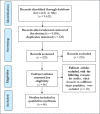CrossFit® Training Strategies from the Perspective of Concurrent Training: A Systematic Review
- PMID: 33239940
- PMCID: PMC7675627
CrossFit® Training Strategies from the Perspective of Concurrent Training: A Systematic Review
Abstract
In the basic principles of CrossFit®, the goal is to improve fitness, related to the simultaneous development of strength and endurance. This is also the main idea of concurrent training, which has been researched since the 1980s. This article aimed to analyze the acute and chronic effects of CrossFit® and to assess the relevance of using the concurrent training methodology. The findings show that CrossFit® is an intense form of exercise that affects the function of the endocrine, immune, and central nervous systems. It also has potential in the development of strength and endurance parameters. These conclusions were compared with relevant concurrent training studies. Although the CrossFit® interventions (workouts of the day) have much in common with concurrent training, methodological recommendations can only be partially transferred. The approach for training and athlete development must be based on the originality of this sport.
Keywords: Performance; concurrent exercise; high intensity; training load.
© Journal of Sports Science and Medicine.
Figures
References
-
- Aucher H. (2014) 209,585: Rise of the Open. Retrieved 26th of June’. 2020, from https://games.crossfit.com/article/209585-rise-open.
-
- Bailey B., Benson A. J., Bruner M. W. (2019) Investigating the organisational culture of CrossFit, International Journal of Sport and Exercise Psychology 17(3), 197–211.
-
- Barfield J., Anderson A. (2014) Effect of CrossFit on health related physical fitness: A pilot study. Journal of Sport and Human Performance, 2(1), 23–28.
-
- Berryman N., Mujika I., Bosquet L. (2019) Concurrent Training for Sports Performance: The 2 Sides of the Medal. International Journal of Sports Physiology and Performance 14(3), 279–285. - PubMed
Publication types
MeSH terms
LinkOut - more resources
Full Text Sources
Medical

